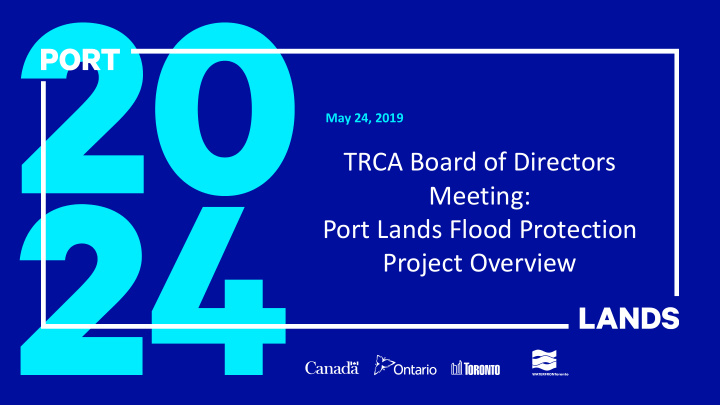



May 24, 2019 TRCA Board of Directors Meeting: Port Lands Flood Protection Project Overview
David Kusturin, Chief Project Officer, Waterfront Toronto Kenneth Dion, Project Director, Port Lands Integration, Waterfront Toronto
Overview • Purpose of Presentation: Inform the Board for their future decision-making over next 4 years • What is Waterfront Toronto • What is the PLFP and TRCA’s Role in PLFP • Project Background • PLFP is 23 Projects in 1 • Environmental Management • River Valley Design & Construction • River Ecologies and Habitat • Questions 3
What is Waterfront Toronto?
Waterfront Toronto is working to revitalize the lands by Lake Ontario, transforming past industrial sites into thriving neighbourhoods that support economic vitality and enhance quality of life . Our mandate comes from the three orders of government; our resources come from both public and private sources. As we work on behalf of Torontonians, Ontarians, and all Canadians, every decision we make is guided by our vision of one vibrant waterfront that belongs to everyone .
Designated Waterfront Area West Don Lands East Bayfront Central Waterfront Port Lands
Public accountability Reducing urban sprawl Building sustainable communities Increasing affordable housing Creating parks & public spaces Expanding public transit Driving economic competitiveness
What is the Port Lands Flood Protection Project?
Project Timeline and Process Amalgamation of two Don Mouth Naturalization and Port Lower Don Lands (LDL) Class EA approved Environmental Lands Flood Protection EA Assessments (EAs) Waterfront Toronto with the TRCA with Waterfront Toronto and the City of Toronto and Toronto Transit City of Toronto Company Objective: Used the DMNP EA as baseline to “Establish and sustain the form, features, determine footprint for naturalization and and functions of a natural river mouth developable lands within the context of a revitalized City environment while providing flood Identified location and type of protection up to the Regulatory Flood.” roads, bridges, servicing and transit infrastructure required in LDL area. 2005 2005-20 2015 2008-20 2008 2015 9
Due Diligence Port Lands Flood Protection and Enabling Infrastructure Due Diligence Study: 2015-2016 Merged the results of two EAs into a single project Confirmed costs, constructability considerations and schedule Cherry Street Lakefilling received tri-government funding in October 2016 Tri-government funding for the remainder of the project announced in June 2017
Roles of TRCA • Eligible Receipt – TRCA identified by Levels of Government in 2001 • DMNP EA - Lead and Co-Proponent with Waterfront Toronto, City of Toronto • Floodplain Regulator – Construction permits • Technical expertise - Water resource engineering, subsurface engineering / hydrogeology, ecological restoration and EA project management • Monitoring - Environmental, ecological and archaeological • Potential future landowner/operator - components of the design • Annual EA Compliance Reporting • Project Support to Waterfront Toronto throughout the Project implementation
Project Background
Looking east during construction of the Keating Channel in 1914.
Industrial uses like the oil storage tanks seen in this photo in the 1920s have left a legacy of contamination in the Port Lands.
Regulatory Flood – Current Conditions 1800 1600 1400 Flow Rate (m 3 /s) 1200 1000 800 600 400 200 0 normal 1 2 5 10 50 100 Hurricane Flood Frequency (years) 15
Regulatory Flood – Future Conditions 16
17 Flood Protection Design
Flood Remediation Design
23 Projects in 1
PLFP Coordination with Other Major Public Initiatives
What are we building?
Full Vision Plan
Funded Project Areas
Three Streets for the Port Lands 24
Three Bridges for the Port Lands
Environmental Management
Historical Site Use • Historical infilling • Crude Oil/Petroleum Refining and Storage • Explosives and Ammunition Manufacturing • Metal Treatment and Fabrication • Concrete and Cement Manufacturing Images from http://www.blogto.com/city/2012/02/what_th e_port_lands_used_to_look_like/
Contaminant Extent
Peat Assessment • former marshland of the Don River has left a legacy of peat deposits Peat Contour Map
Assessing Risk • No current environmental approval process in Ontario for a project of this nature • Community-Based Risk Assessment allows us to: • Identify and evaluate the risks to human health and the environment • Develop effective measures to mitigate or remove those risks • Develop a comprehensive strategy for treating and reusing soil within the project area (1.5M m3 to be excavated) • Support the creation of the new landmasses
River Valley Design & Construction Overview
Cutoff Wall Installation Multiple construction methods available: secant pile wall, slurry wall • Specifications will included performance requirements during installation and post installation • Also provides constructability benefits: minimizes dewatering and permits drier excavation •
Example Cross-Section
Six Steps to Construction Step 1 – Shallow Excavation Step 2 – Cut-off Wall Installation Step 3 – Deep Excavation Step 4 – Install Underdrain and Horizontal Barriers Step 5 – Install Clean Grading and River Finishes Step 6 – Connecting to the Lake
Flood Protection Landform & Valley Wall Feature
River Ecologies and Habitat
Seasonal Water Fluctuations Influence on Plant Community Distribution
Plant Communities - Section
River Ecology: Plant Communities and Habitat
Questions
Recommend
More recommend